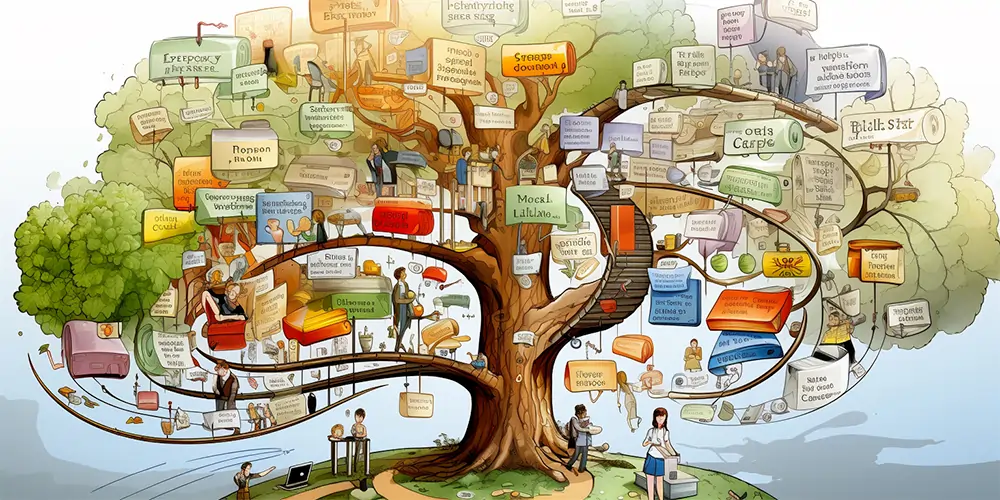ChatGPT, the creation of OpenAI, has sparked significant interest and attention since its introduction in late 2022.
The AI-based chatbot has received a lot of attention in tech communities and beyond, prompting curious and innovative applications from users.
It has become the fastest growing ‘app’ to date, surpassing even popular platforms like TikTok.
What Makes ChatGPT Stand Out
The appeal of ChatGPT doesn’t solely rest on the novelty of the concept.
Instead, the combination of the model’s performance in text generation and its ease of use sets it apart.
Able to carry out text-based conversations with users by leveraging AI, interactions with ChatGPT can feel as seamless as conversing with another human being.
ChatGPT is versatile, with users employing it for a wide range of tasks. From seeking humorous answers to generating content, improving writing or Excel skills, debugging code, or summarising literature, the possibilities are vast.
The potency of this AI chatbot has sparked discussions on its potential to transform various industries and even replace professionals like programmers, writers, and doctors.

How to Access ChatGPT
To get started with ChatGPT, you first need to register for an account.
This process is simple. Navigate to chat.OpenAi.com and sign up with an email address, or a Google or Microsoft account.
OpenAI does require a valid phone number for verification purposes.
After account creation, log in to your OpenAI account and access ChatGPT’s interface. The interface layout is designed for ease of use, providing various options and tools for an intuitive user experience.
ChatGPT’s Architecture
The core of ChatGPT lies in its deep learning architecture: the Transformer model.
The Transformer model is a type of neural network that uses self-attention mechanisms, allowing it to excel in understanding the context and generating coherent text. But it’s not just any Transformer model – it’s a variant called GPT (Generative Pre-trained Transformer), specifically the fourth iteration, GPT-4.
The GPT-4 model, like its predecessors, has been trained on a vast amount of text data. This includes books, articles, and websites, among other sources.
The model learns patterns, contexts, and relationships between words and phrases, which it then utilises to generate meaningful and contextually relevant responses.
Applications of ChatGPT
While entertaining and informative conversations form a significant chunk of ChatGPT’s use, its potential extends far beyond casual chat.
Users are already utilising it for:
- Learning and education: ChatGPT can serve as a tutor, helping to explain concepts in various fields. Its ability to generate examples and explain complex ideas in simple terms makes it an excellent learning tool.
- Content creation: For writers, journalists, and marketers, ChatGPT can be a source of inspiration and a tool for generating ideas, outlines, drafts, and even complete articles.
- Coding and debugging: With knowledge of various programming languages and debugging techniques, ChatGPT can assist programmers in writing and reviewing code.
Prompting ChatGPT Effectively
When interacting with ChatGPT, the way you structure your prompt can significantly influence the quality and relevance of the response.
Here are some tips to get the most out of your interactions:
- Be Explicit: Clarity and specificity are key when you formulate your prompt. If the question is too vague, the AI may not provide the desired information.
- Provide Context: Including context in your prompt can help to guide the model’s responses. For instance, if you are seeking advice on writing a book, specifying the genre can help the model generate more relevant advice.
- Length of the Prompt: While shorter prompts can often suffice, longer prompts can help provide additional context, especially for complex questions or topics.
- Control Tokens: Certain control tokens or instructions can help guide the model’s output. Specifying that you want the answer in bullet points, or as a story, can help shape the form of the response.

Future Prospects and Challenges
The rise of ChatGPT marks a significant milestone in artificial intelligence.
Its potential is undeniable, with users finding new applications and benefits regularly. However, the technology also faces some significant challenges.
One primary concern is the ethical implications of AI usage.
The risk of misuse, from generating misleading information to propagating bias, is real. It’s a problem OpenAI acknowledges and is actively working to address.
The accuracy and relevance of the information provided by ChatGPT is another challenge.
While the model is trained on vast datasets, it can still generate incorrect or nonsensical answers.
Ensuring the AI’s reliability is a continued focus of development.
The Path Forward
Artificial intelligence, specifically in the form of conversational models like ChatGPT, is undeniably revolutionising the way we interact with technology.
Despite the journey ahead being strewn with obstacles, from technical hurdles to ethical dilemmas, the immense prospective advantages are far too consequential to disregard.
As we encounter these challenges, OpenAI’s mission of ensuring that AGI benefits all of humanity remains more relevant than ever.
ChatGPT’s current iteration, ChatGPT-4, is a demonstration of progress in this direction, offering a more advanced, reliable, and versatile tool for individuals and businesses.
However, this development marks only the start of an intriguing journey.
As this technology evolves, conversational AI is poised to weave itself seamlessly into the fabric of our digital existence, providing tailored assistance, boosting efficiency, and facilitating digital exchanges that are increasingly intuitive and human-esque.

Looking Forward to ChatGPT’s Possibilities
As we strive to explore new possibilities and expand our limits with artificial intelligence, it’s thrilling to consider the advancements and capabilities that future iterations of the ChatGPT model might offer.
We’ve already seen how transformative these AI tools can be in numerous fields, and it’s only the beginning.
Creative Collaboration
In the creative arts, the ChatGPT model could become a powerful collaborative tool.
Imagine a version of ChatGPT that can help you brainstorm story ideas, create complex characters, and even draft plotlines in real-time.
Or, in music, imagine an AI that can compose melodies to your lyrics, or vice versa, contributing to the creation of new and unique pieces of music.
We are close enough for both of these!
Advanced Language Learning
Language learning could also see significant advancements with future models.
With a more advanced understanding of context and syntax, these AI models could offer immersive language learning experiences that adapt to the learner’s skill level, offering personalised teaching and practice.
Health and Wellness
Future ChatGPT iterations could provide mental health support in healthcare, delivering therapeutic conversations and mindfulness exercises.
With rigorous safeguards for privacy and professional oversight, these AI models could offer round-the-clock support for individuals in need.
Optimised Business Operations
For business, future versions could offer optimised, personalised recommendations for operational efficiency.
These AI tools could analyse the full scope of a business’ operations, providing insights and proposing strategies to optimise performance across the board.
Personal Digital Assistant
One of the most exciting prospects is the potential for a truly personalised digital assistant.
Imagine an AI that understands your preferences, your schedule, your tastes in music, food, or fashion – and can make recommendations, perform tasks, or even carry on a conversation based on these preferences.
Future iterations of GPT could make this a reality.
Though these future scenarios may seem to reside in the domain of science fiction, it’s crucial to remember that we are steadily advancing towards these possibilities each day.
While teeming with potential, these advancements simultaneously underscore the necessity to wield these tools with ethical integrity, ensuring vigilant regard for privacy and security.
As we gaze into the future, the capabilities of GPT and AI tools are only constrained by the boundaries of our imagination.
With each technological advancement, the distinction between what we once considered science fiction and our current reality grows ever more indistinct.

Frequently Asked Questions
Understanding ChatGPT
This captivating AI tool uses machine learning capabilities to comprehend and produce text that mimics human conversation, thus transforming it into an exceptional instrument for a wide array of applications.
As we explored in this article, we’ve learned how ChatGPT is trained using a two-step process of pre-training and fine-tuning.
We also dived into some practical applications of ChatGPT, from writing assistance to gaming, and how it is changing the dynamics of these fields.
Through our discussion of guidelines for prompt design, we discovered how to effectively communicate with ChatGPT to get the best results. This involves crafting well-structured, explicit prompts that give the AI model clear direction.
We also covered some of the frequently asked questions about ChatGPT, offering a better understanding of how this AI model works and its potential and limitations.
Looking into the future, it’s exhilarating to imagine the potential advancements and capabilities of future iterations of ChatGPT.
From becoming a powerful collaborative tool in the creative arts to offering personalised language learning experiences and providing round-the-clock mental health support, the possibilities are limited only by our imagination.
As we continue to refine and develop AI tools like ChatGPT, we must ensure that these tools are used ethically and responsibly.
The journey with ChatGPT is just beginning, and it’s exciting to imagine where this path might lead us.




